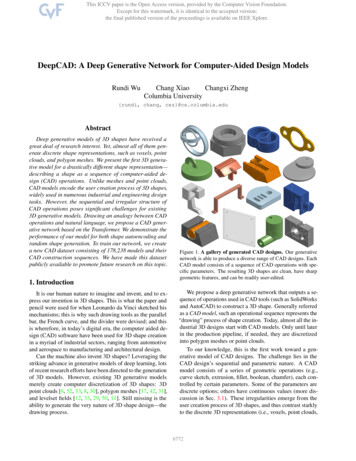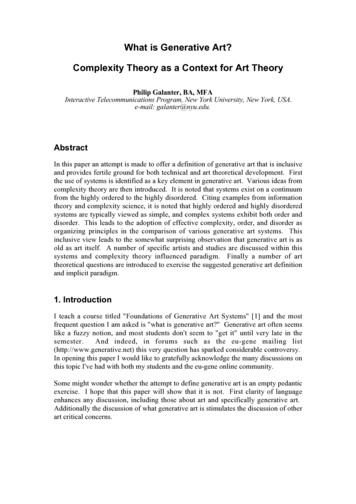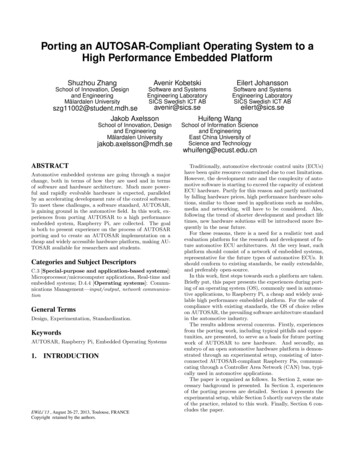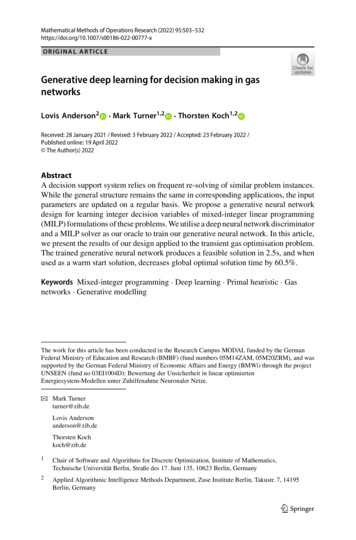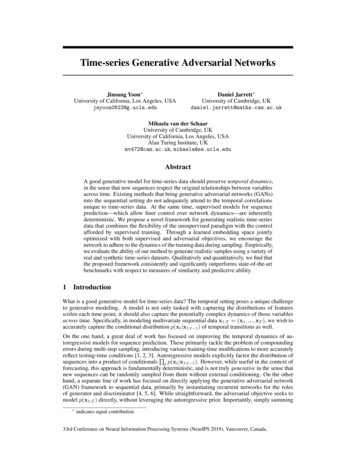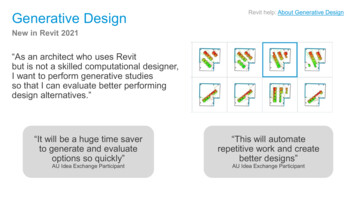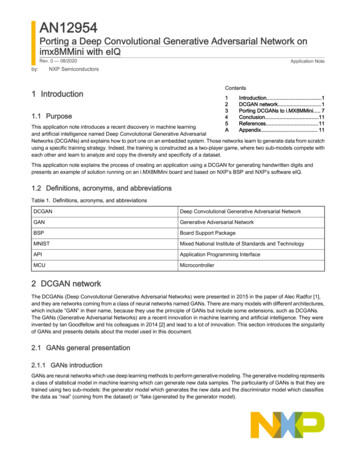
Transcription
AN12954Porting a Deep Convolutional Generative Adversarial Network onimx8MMini with eIQRev. 0 — 08/2020by:Application NoteNXP SemiconductorsContents1 Introduction12345A1.1 PurposeIntroduction.1DCGAN network.1Porting DCGANs to i.MX8MMini. 7Conclusion.11References. 11Appendix. 11This application note introduces a recent discovery in machine learningand artificial intelligence named Deep Convolutional Generative AdversarialNetworks (DCGANs) and explains how to port one on an embedded system. Those networks learn to generate data from scratchusing a specific training strategy. Indeed, the training is constructed as a two-player game, where two sub-models compete witheach other and learn to analyze and copy the diversity and specificity of a dataset.This application note explains the process of creating an application using a DCGAN for generating handwritten digits andpresents an example of solution running on an i.MX8MMini board and based on NXP’s BSP and NXP’s software eIQ.1.2 Definitions, acronyms, and abbreviationsTable 1. Definitions, acronyms, and abbreviationsDCGANDeep Convolutional Generative Adversarial NetworkGANGenerative Adversarial NetworkBSPBoard Support PackageMNISTMixed National Institute of Standards and TechnologyAPIApplication Programming InterfaceMCUMicrocontroller2 DCGAN networkThe DCGANs (Deep Convolutional Generative Adversarial Networks) were presented in 2015 in the paper of Alec Radfor [1],and they are networks coming from a class of neural networks named GANs. There are many models with different architectures,which include “GAN” in their name, because they use the principle of GANs but include some extensions, such as DCGANs.The GANs (Generative Adversarial Networks) are a recent innovation in machine learning and artificial intelligence. They wereinvented by Ian Goodfellow and his colleagues in 2014 [2] and lead to a lot of innovation. This section introduces the singularityof GANs and presents details about the model used in this document.2.1 GANs general presentation2.1.1 GANs introductionGANs are neural networks which use deep learning methods to perform generative modeling. The generative modeling representsa class of statistical model in machine learning which can generate new data samples. The particularity of GANs is that they aretrained using two sub-models: the generator model which generates the new data and the discriminator model which classifiesthe data as “real” (coming from the dataset) or “fake (generated by the generator model).
NXP SemiconductorsDCGAN networkGANs have been researched since their introduction in 2014. Since then, a lot of improvement has been demonstrated, and nowthese models achieve remarkable results and performance. The figures below show the impressive evolution of GANs resultssince 2014:Figure 1. Generated images using a GAN, presented by Ian Goodfellow in his paper in 2014 [2], the format of picturesis 64x64Figure 2. Generated images using a coupled GAN, presented by Ming-Yu Liu and Oncel Tuzel in their paper inSeptember 2016 [3], the format of pictures is 128x128Figure 3. Generated images using a progressively growing GAN, presented by Tero Karras, Timo Aila, Samuli Laineand Jaakko Lehtinen in their paper in February 2018 [4], the format of pictures is 1024x1024Application NotePorting a Deep Convolutional Generative Adversarial Network on imx8MMini with eIQ, Rev. 0, 08/20202 / 12
NXP SemiconductorsDCGAN networkThe GANs performance has been improved a lot since their introduction, and now it is capable of generating photos that are sorealistic that even humans can’t tell if they are real or fake. However, the application areas have evolved too, and nowadays GANsare used in a lot of different domains.2.1.2 GANs applicationA lot of researchers work on GANs and discover the wide possibilities of applications. The best known application is the generationof synthetic images similar to the dataset used during the training. This is very impressive and researchers successfully generatedconvincing results, such as photographs of humans faces, cartoon characters, maps, and so on. This is a very good way to performdata augmentation, which is a big benefit for neural network training. In the machine learning application, it takes long to gatherenough data to create a dataset. The more diverse data you have, the better chance you have to train a robust network. The dataaugmentation is a real chance to improve the performance of a network. Working with GANs allows to use a small amount of dataand generate new data.Lots of new GANs applications have been demonstrated. For example, GANs have shown their capacity to perform anomalydetection, which is a topic highly used in domains such as manufacturing, medical imaging, and cyber security. It has beenalso used for video prediction, text-to-image translation, 3D object generation, and image high resolution. The possibilities ofapplications are wide and interesting to more and more people. That is why GANs are a powerful tool for innovation.Figure 4. Chanterelle mushroom dataset samples and generated 3D shapes from the inverse graphics GAN modelintroduced by Sebastian Lunz, Yingzhen Li, Andrew Fitzgibbon and Nate Kushman in their paper February2020 [5]2.1.3 Training GANsThe training of GANs is very singular and uncommon because it involves two sub-models: the generator model, which generatesnew data, and the discriminator model, which classifies the data as “real” (coming from the dataset) or “fake” (generated by thegenerator model). The two sub-models play a “game” which can be compared to a forger and the police, where the forger is thegenerator and the police is the discriminator. The generator generates samples which resemble the train data and try to fool thediscriminator. The discriminator tries to not be fooled by classifying the samples coming from the generator (fake data) and thosecoming from the dataset (real data). It can be compared to a forger wanting to counterfeit money by making it as legitimate aspossible, while the police try to identify the real and fake money. The generator input is random noise and the discriminator takesthe samples created by the generator or the dataset. The GANs architecture is shown in Figure 5.Application NotePorting a Deep Convolutional Generative Adversarial Network on imx8MMini with eIQ, Rev. 0, 08/20203 / 12
NXP SemiconductorsDCGAN networkFigure 5. GANs architectureThe difficulty of this training is the fact that the two sub-models must be trained simultaneously and the improvement of one modelmust lead to the improvement of the other. If the generator is not good enough, the discriminator has no problem to classify the“real” and “fake” data and the model does not converge. If the discriminator is not good enough, a badly generated image isclassified as real, and the model does not produce the desired data. To avoid these situations, the generator and discriminatorlosses are used during the training. The discriminator loss quantifies how well the model achieves the differentiation between realand fake images, and the generator loss quantifies how well the model can trick the discriminator. The training strategy lies in thefact that the two losses are calculated for each sub-models and used to update the weights of the generator and discriminator.The GANs training is done by alternating between these two parts: Firstly, the training of the discriminator is executed while the generator is idle. The discriminator is trained on two batchesof data: a batch of real data and a batch of fake data. Two losses are then calculated for each batch and the discriminatorloss is measured by computing the average. Secondly, the training of the generator is executed while the discriminator is idle. The predictions of the discriminator areused to train the generator: the loss of the generator is computed based on the probability that the discriminator predictsthat the data generated by the generator are real.The training schema is shown in Figure 6.Figure 6. GANs training schemaApplication NotePorting a Deep Convolutional Generative Adversarial Network on imx8MMini with eIQ, Rev. 0, 08/20204 / 12
NXP SemiconductorsDCGAN networkAfter the training is done, GANs have a particularity for their evaluation. The performance of trained GANs is challenging toevaluate because GANs use two loss functions unlike other deep-learning neural networks. This means that the model evaluationmust be estimated using the quality of the generated data. The common evaluation is made by manual inspection. It enables youto check the quality using human eyes that can verify the precision and details of generated outputs. However, few quantitativemeasures are introduced and they can provide a robust evaluation, such as the inception score offered by Tim Salimans, etal. in their 2016 paper titled “Improved Techniques for Training GANs” [6] and the Frechet inception distance introduced byMartin Heusel, et al. in their 2017 paper titled “GANs Trained by a Two Time-Scale Update Rule Converge to a Local NashEquilibrium” [7].2.2 DCGANs used in this AN2.2.1 ModelIn this document, the model used is a Deep Convolutional Generative Adversarial Network (DCGAN) based on the paper of AlecRadfor presented in 2015 [1]. Figure 7 shows the generator model (on the left) and the discriminator model (on the right), with alltheir layers. The particularity of DCGANs is that they use deep convolutional neural networks for the generator and discriminator,whereas GANs usually use fully-connected networks. There are other distinctions, such as the fact that maxpool layers arereplaced by learnable upsampling, the fully connected layer of the discriminator’s output is substituted with a flatten and sigmoidlayer, the application of Batch Normalization to layers, and other. The advantage of using convolutional neural networks and theother modifications is that it ensures a more stable architecture. By forcing these constraints on the model, it enables you to traina high-quality generator model and that is why DCGANs is the basis of a substantial number of GANs extensions.Application NotePorting a Deep Convolutional Generative Adversarial Network on imx8MMini with eIQ, Rev. 0, 08/20205 / 12
NXP SemiconductorsDCGAN networkFigure 7. Keras model visualization in Netron: generator (left) and discriminator (right)2.2.2 MNIST datasetThe Mixed National Institute of Standards and Technolog MNIST(MNIST) dataset [8] is a large dataset which gathers 70,000images of handwritten digits and their labels, where 60,000 are used for training and 10,000 are used for testing. The digits arecentered, grayscale, between 0 to 9, and their format is 28x28.Application NotePorting a Deep Convolutional Generative Adversarial Network on imx8MMini with eIQ, Rev. 0, 08/20206 / 12
NXP SemiconductorsPorting DCGANs to i.MX8MMiniFigure 8. MNIST dataset sampleIt was released in 1999 and it has helped to research the benchmarking classification algorithm. Since the explosion of machinelearning, the MNIST dataset has been used as the “hello world”. Therefore, it is appropriate to use this dataset as a neutral usecase for porting DCGANs to an embedded system.3 Porting DCGANs to i.MX8MMini3.1 Network training with KerasThe model’s implementation chosen for this example is available on GitHub and it is the work of Erik Linder-Norén [9], who is amachine learning engineer. GitHub gathers a collection of GANs implementations based on the models described in researchpapers. The implementation is written in Python and it uses API Keras which is an open-source neural network API written inPython. The feature of this API is that it is user-friendly, high-level, and capable of running on top of different back-ends, such asTensorFlow, CNTK, or Theano.To train DCGANs, clone the GitHub repository, and go to the DCGAN implementation folder: git clone https://github.com/eriklindernoren/Keras-GAN cd Keras-GAN/dcgan/In this implementation, the network described in Model is ready to be trained. The training is completed according to this scheme:For each epoch and for each batch of data:1. Generate noise vectors of dimension 100.2. Generate fake data using noise vectors as the generator’s input.3. Input fake data to the discriminator to get the discriminator’s loss on fake data.4. Input real data to the discriminator to get the discriminator’s loss on real data.5. Calculate the generator loss.6. Calculate the discriminator loss.7. Update the gradients to minimize the loss values.Application NotePorting a Deep Convolutional Generative Adversarial Network on imx8MMini with eIQ, Rev. 0, 08/20207 / 12
NXP SemiconductorsPorting DCGANs to i.MX8MMiniIn this code, the “epoch” variable is misleading. In the deep-learning vocabulary, it represents the number of completepasses through the dataset during the training. Here, it is the number of times that the model is trained on one batch. Toachieve better results, the number of epochs must be increased. The code does not include saving the model after thetraining, so few modifications must be done. For that, apply the dcgan-training.patch patch available in the repository eiq-DCGAN-application-note by executing this command: git apply dcgan-training.patchAfter applying the patch, launch the training using this command: python dcgan.pyIn this document, the version of TensorFlow used is TensorFlow 1.15. After launching the training, the summary of the twosub-models are printed and a few interesting information are displayed, as shown in Figure 9.Figure 9. Display of the model’s information: generator (right) and discriminator (left)All the layers, output shapes, and number of trainable and non-trainable parameters are indicated, which provides an idea of thetraining extension.During the training, the following information is printed in the terminal:1 [D loss: 0.685027, acc.: 57.81%] [G loss: 0.982729]2 [D loss: 0.574230, acc.: 67.19%] [G loss: 1.022767]3 [D loss: 0.356288, acc.: 82.81%] [G loss: 0.921926]For each epoch, which is the first number on the left, the accuracy of the discriminator and the losses of the discriminator andgenerator are displayed. This is a good way to monitor the evolution of the training and to ensure its good progression.During the training, samples of generated images are saved at a pre-defined interval and the performance of the training can beobserved. The generated images saved at different intervals of the training are shown in Figure 10.Application NotePorting a Deep Convolutional Generative Adversarial Network on imx8MMini with eIQ, Rev. 0, 08/20208 / 12
NXP SemiconductorsPorting DCGANs to i.MX8MMiniFigure 10. Evolution of generated data along the trainingThe progression is clearly shown in the generated images at epoch 0, the generated images are made of noise, and the shapesof digits are appearing at epochs 600. They are then refined at epoch 2200 and the generated images look like the MNIST Digitsat the last epoch. At the end of the training, the discriminator, generator, and combined models are saved in the *.h5 and *.jsonformats. The *.h5 format is used for the conversion in Tflite, which is described in the next section.3.2 Conversion in TFliteTensorFlow Lite is a light-weight version of TensorFlow which offers a set of tools and core operators for the floating and quantizedata to optimize the integration of TensorFlow models on Android OS and iOS devices, embedded and IoT devices, and MCUs.It enables on-device deep learning inference with low latency and optimization of the trained Keras or TensorFlow models.A precise guide for the TFlite quantization during the conversion is available on the NXP website 07/15/eiq-sample-apps-tflite-quantization. In this document, the model runs on the CPU of i.MX8M Mini,so during the conversion from Keras to TFlite model, the parameters are kept in float. However, only the generator model is keptfor the conversion because the goal of this document is to create an application which generates new images, so the discriminatoris not needed. The conversion can be done using the converter command line or using the Python API. To use the python API,create a new Python file and type the following lines into it:import tensorflow as tfimport warningswarnings.filterwarnings('ignore')#model tf.keras.models.load model("dcgan/saved model/generator model.h5")converter tf.lite.TFLiteConverter.from keras model file("dcgan/saved model/generator model.h5")tfmodel converter.convert()open ("dcgan generator.tflite" , "wb") .write(tfmodel)After launching the script, the generator model is converted into a TFlite model and ready to be deployed on the i.MX8MMini.Application NotePorting a Deep Convolutional Generative Adversarial Network on imx8MMini with eIQ, Rev. 0, 08/20209 / 12
NXP SemiconductorsPorting DCGANs to i.MX8MMini3.3 eIQThe NXP eIQ machine-learning software development environment is created to facilitate the development of applications usingmachine-learning algorithms on NXP MCUs, i.MX RT crossover MCUs, and i.MX family SoCs. It provides a set of libraries anddevelopment tools which includes inference engines, neural network compilers, and optimized libraries.However, eIQ is dedicated to achieve inference of networks and standard machine-learning algorithms, so this is why the DCGANtraining was previously done on a Linux OS computer.The advantage of eIQ is that it can be used with a wide range of frameworks and inference engines like TensorFlow Lite, Arm NN,and Arm Compute Library. For more information on this software, see the NXP website oftware/eiq-ml-development-environment).For this project, the TensorFlow Lite library integrated in the eIQ is used. To use this on i.MX8MMini, two things are needed: aBSP containing the eIQ software for the i.MX8MMini board and the toolchain with eIQ on the host machine.The Yocto BSP and the toolchain can both be generated. For more information, see linux-for-i-mx-applications-processors:IMXLINUX forgenerating the BSP, and NXP eIQ Machine Learning Software Development Environment for i.MX Applications Processors(document UM11226) section 3.2.9. Generating the Toolchain” for generating the toolchain.3.4 Implementation detailsNow that the model is trained and converted into an adapted format for an embedded system, the last step is to create anapplication which performs the inference on i.MX8MMini with the software eIQ. The source code of the application is available onCode upport/eiq-DCGAN-application-note/This application uses the C TensorFlow Lite library to load and interpret the TFlite model and to perform inference. The resultingimages generated by the DCGAN are displayed on the screen connected to the board.To compile on the host machine, download the application and add the trained TFlite model into the folder. Then source thetoolchain. This toolchain provides a set of tools including compilers, libraries, and header files which allow to cross-compile thecode for the image used on the i.MX8MMini board. After sourcing the toolchain, compile the application by running the following: make -f Makefile.linuxIt generates the binary DCGAN that can be executed on the board. Now that the binary of the application is created, power thei.MX8MMini board and connect a display to the board using an IMX-MIPI-HDMI adapter. Create a new folder on the board andcopy the binary with the TFlite model and run the application by executing the binary as follows:root@imx8mmevk:dcgan/ # ./DCGANDuring the execution, 10 generated images are displayed on the screen and saved on the board in the result im number.png file.They can be seen afterward using the following command:root@imx8mmevk:dcgan/ # Weston-image result im number.pngFigure 11 shows examples of three generated images representing the handwritten digit “0” created on the board.Figure 11. Handwritten digits “0” generated on the i.MX8MMiniApplication NotePorting a Deep Convolutional Generative Adversarial Network on imx8MMini with eIQ, Rev. 0, 08/202010 / 12
NXP SemiconductorsConclusion4 ConclusionThis application note introduces the DCGAN networks and the challenge of generating new images of handwritten digits usingdeep learning. It demonstrates an example of DCGAN application running on the i.MX8MMini embedded system i using theNXP software eIQ. This allows to also show a development’s demonstration of an application using deep learning on an NXPboard, from the training done on an host machine to the deployment on an embedded system. This process is simplified witheIQ, which provides an opportunity to develop and deploy lots of applications using artificial intelligence and machine learning.eIQ keeps getting upgraded, advanced, and optimized, which enhances the possibilities of implementating innovation on an NXPembedded system.5 References Jason Brownlee (2019): introduction to Generative Adversarial Networks ive-adversarial-networks-gans/ Jason Brownlee (2019): example of GANs applications ications-ofgenerative-adversarial-networks/ Open Data Science (2019): example of GANs use cases cab2aa924dA Appendix1. Alec Radfor (2015): introduction of DCGAN https://arxiv.org/pdf/1511.06434.pdf2. Ian J. Goodfellow (2014): introduction of GAN https://arxiv.org/pdf/1406.2661.pdf3. Ming-Yu Liu, Oncel Tuzel (2016): introduction of Coupled GANhttps://arxiv.org/pdf/1606.07536.pdf4. Tero Karras, Timo Aila, Samuli Laine and Jaakko Lehtinen (2018): i ntroduction of Progressively Growing GANhttps://arxiv.org/pdf/1710.10196.pdf5. Sebastian Lunz, Yingzhen Li, Andrew Fitzgibbon and Nate Kushman (2020): introduction of Inverse Graphics GANmodel https://arxiv.org/pdf/2002.12674.pdf6. Tim Salimans , et al. (2016): introduction of inception scorehttps://arxiv.org/pdf/1606.03498.pdf7. Martin Heusel, Hubert Ramsauer, Thomas Unterthiner, Bernhard Nessler (2018): introduction of Frechet inceptionhttps://arxiv.org/pdf/1706.08500.pdf8. LeCun, Y. (1999) : The Mnist Database http://yann.lecun.com/exdb/mnist/9. Erik Linder-Norén (2018): implementation of GANs family in Keras ation NotePorting a Deep Convolutional Generative Adversarial Network on imx8MMini with eIQ, Rev. 0, 08/202011 / 12
How To Reach UsHome Page:nxp.comWeb Support:nxp.com/supportInformation in this document is provided solely to enable system and software implementersto use NXP products. There are no express or implied copyright licenses granted hereunderto design or fabricate any integrated circuits based on the information in this document. NXPreserves the right to make changes without further notice to any products herein.NXP makes no warranty, representation, or guarantee regarding the suitability of its productsfor any particular purpose, nor does NXP assume any liability arising out of the applicationor use of any product or circuit, and specifically disclaims any and all liability, includingwithout limitation consequential or incidental damages. “Typical” parameters that may beprovided in NXP data sheets and/or specifications can and do vary in different applications,and actual performance may vary over time. All operating parameters, including “typicals,”must be validated for each customer application by customer's technical experts. NXP doesnot convey any license under its patent rights nor the rights of others. NXP sells productspursuant to standard terms and conditions of sale, which can be found at the following address:nxp.com/SalesTermsandConditions.While NXP has implemented advanced security features, all products may be subject tounidentified vulnerabilities. Customers are responsible for the design and operation of theirapplications and products to reduce the effect of these vulnerabilities on customer’s applicationsand products, and NXP accepts no liability for any vulnerability that is discovered. Customersshould implement appropriate design and operating safeguards to minimize the risks associatedwith their applications and products.NXP, the NXP logo, NXP SECURE CONNECTIONS FOR A SMARTER WORLD, COOLFLUX,EMBRACE, GREENCHIP, HITAG, ICODE, JCOP, LIFE VIBES, MIFARE, MIFARE CLASSIC,MIFARE DESFire, MIFARE PLUS, MIFARE FLEX, MANTIS, MIFARE ULTRALIGHT,MIFARE4MOBILE, MIGLO, NTAG, ROADLINK, SMARTLX, SMARTMX, STARPLUG, TOPFET,TRENCHMOS, UCODE, Freescale, the Freescale logo, AltiVec, CodeWarrior, ColdFire,ColdFire , the Energy Efficient Solutions logo, Kinetis, Layerscape, MagniV, mobileGT, PEG,PowerQUICC, Processor Expert, QorIQ, QorIQ Qonverge, SafeAssure, the SafeAssure logo,StarCore, Symphony, VortiQa, Vybrid, Airfast, BeeKit, BeeStack, CoreNet, Flexis, MXC, Platformin a Package, QUICC Engine, Tower, TurboLink, EdgeScale, EdgeLock, eIQ, and Immersive3Dare trademarks of NXP B.V. All other product or service names are the property of theirrespective owners. AMBA, Arm, Arm7, Arm7TDMI, Arm9, Arm11, Artisan, big.LITTLE, Cordio,CoreLink, CoreSight, Cortex, DesignStart, DynamIQ, Jazelle, Keil, Mali, Mbed, Mbed Enabled,NEON, POP, RealView, SecurCore, Socrates, Thumb, TrustZone, ULINK, ULINK2, ULINK-ME,ULINK-PLUS, ULINKpro, µVision, Versatile are trademarks or registered trademarks of ArmLimited (or its subsidiaries) in the US and/or elsewhere. The related technology may be protectedby any or all of patents, copyrights, designs and trade secrets. All rights reserved. Oracleand Java are registered trademarks of Oracle and/or its affiliates. The Power Architecture andPower.org word marks and the Power and Power.org logos and related marks are trademarksand service marks licensed by Power.org. NXP B.V. 2020.All rights reserved.For more information, please visit: http://www.nxp.comFor sales office addresses, please send an email to: salesaddresses@nxp.comDate of release: 08/2020Document identifier: AN12954
GANs are neural networks which use deep learning methods to perform generative modeling. The generative modeling represents . The implementation is written in Python and it uses API Keras which is an open-source neural network API written in Python. The feature of this API is that it is user-friendly, high-level, and capable of running on top .
